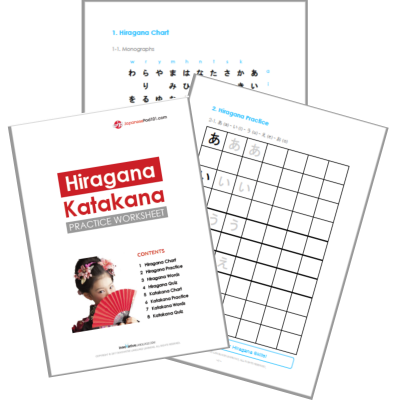Fact is… there are a LOT of Japanese words for rain.
But, the good new is, you don’t need to know them all right now.
As, in there’s no point for you to learn ALL. It’d be like learning ALL of math upfront – calculus, logarithms, and arithmetic at the same time. Baby steps first.
Besides, you would hate me, hate yourself, and maybe even hate the language… if I were to shove the many, many word down your brain tubes. So, in this quick guide, you’ll learn 17+ Japanese words for rain. I’ll update it in the future too… in case you do want more words… but this is enough for beginners.
Let’s go.
 | Want to learn how to write in Japanese? Download your FREE Japanese Alphabet eBook here (click here). |
1. Rain – Ame
- Kanji: 雨
- Kana: あめ
It’s only right for a list of Japanese words for the rain, to begin with… rain! Ame, or rain, is an integral part of Japanese weather, culture, society, and is one of the most common Japanese weather words.
- It’s raining.
- 雨が降っています。
- ame ga futteimasu
By the way, this list will introduce some common Japanese words used to describe rain depending on the season, time of day, severity, as well as common rain onomatopoeias.
2. Lightning/thunder – Kaminari
- Kanji: 雷
- Kana: かみなり
In Japanese, the word kaminari is used to refer to both thunder and lightning (very, very frightening, Galileo!). This word’s Japanese character shares the radical for rain. The pronunciation of the word can be divided into “kami” meaning god, and “nari” meaning to ring or to sound. This creates a powerful image of a God roaring from up above as lightning strikes.
3. Light rain – Kosame
- Kanji: 小雨
- Kana: こさめ
Kosame literally translates to small (ko) rain (ame). Some onomatopoeias in Japanese that describe light rain are potsu-potsu, shito-shito, and para-para.
4. Heavy rain – Ooame
- Kanji: 大雨
- Kana: おおあめ
Similarly, to the previous word in the list, ooame literally translates to big (oo) rain (ame). Some onomatopoeias in Japanese that describe heavy rain are za-za and dosha-dosha. You’ll learn about these later on below.
5. Sudden Rain – Niwaka Ame
- Kana: にわか雨
- Kana: にわかあめ
Niwaka ame is a term used to describe when rain seemingly comes out of nowhere.
Niwaka translates to sudden, unexpected, or abrupt.
6. Heavy evening rain – Yuudachi
- Kanji: 夕立
- Kana: ゆうだち
Yuudachi is similar to niwaka ame, but is connected specifically to the evening time. The first character in yuudachi – Yuu (夕) means evening. Oftentimes, this type of rain is seen during the summer season between June and August, but yuudachi can be used to describe sudden heavy evening rain during any time of the year.
7. Rain in passing – Touriame
- Kanji: 通り雨
- Kana: とおりあめ
Touriame can be broken into two parts – touri, to pass, and ame, rain. This illustrates the meaning of this phrase very well, which describes a type of rain that starts and stops suddenly, as if it were planning on briefly passing through the area. Kind of like the rain in tropical climates.
8. Sunny rain – Tenkiame
- Kanji: 天気雨
- Kana: てんきあめ
Tenkiame can be divided into the words tenki (good weather) and ame (rain). Tenki generally means weather, but is also used to describe sunny weather specifically. We’ve all experienced the feeling of confusion as rain continues to fall while the sun shines bright. This phrase illustrates this exact feeling!
9. Typhoon – Taifuu
- Kanji: 台風
Kana: たいふう
Typhoon is a word that we are all familiar with, but did you know it originated from the Japanese word – taifuu? Japan’s typhoon season can stretch from May to October but usually peaks in the months of August and September. In the western hemisphere, typhoons are often called hurricanes.
10. Rainy season – Tsuyu
- Kanji: 梅雨
- Kana: つゆ
Japan’s rainy season affects much of the country every year. Starting in early May in the Okinawa region, and reaching the Tokyo area in early June, Japan experiences near constant precipitation.
The characters for tsuyu can be broken into plum (梅) and rain (雨). This is because the rainy season tends to align with the plum ripening season. Another symbol for the rainy season is the Hydrangea flower (紫陽花、あじさい、ajisai). They often bloom during June and July, and signify the beginning of summer and the rainy season.
11. Waiting out the rain – Amayadori
- Kanji: 雨宿り
- Kana: あまやどり
Amayadori utilizes the word (宿) which has meanings such as an inn, lodge, home, or dwelling. This helps illustrate the phrase’s meaning of taking shelter during a rainstorm and waiting until the rain passes.
12. Light rain with clear water droplets – Potsu-potsu
- Kanji: n/a
- Kana: ポツポツ
- (onomatopoeia)
The Japanese language utilizes many onomatopoeias. Potsu-potsu is a very commonly used onomatopoeia that describes the sound of rain that has just begun to fall. “Potsu” can help us visualize a singular drop of water hitting the ground followed by a little plop of sound.
13. Light rain – Para-para
- Kanji: n/a
- Kana: パラパラ
- (onomatopoeia)
Para-para is another onomatopoeia that describes the sound of a light rain. If someone was hoping to describe the sound of a light, drizzle, this is the onomatopoeia they would use.
14. Wet soft rain – Shito-Shito
- Kanji: n/a
- Kana: しとしと
- (onomatopoeia)
Shito-shito is an onomatopoeia that also describes the sound of drizzling rain.
However, shito-shito gives off the impression of a more lingering rain, heavier than the
rain described by the onomatopoeia para-para. However, each onomatopoeia may be
interpreted slightly differently depending on the individual.
15. Heavy Rain – Za-za
- Kanji: n/a
- Kana: ザーザー
- (onomatopoeia)
This onomatopoeia describes a very heavy rain. This not only includes the description of the sound of rain, but also allows us to imagine the zipping wind that comes along with a heavy rainfall.
16. Downpour/Heavy Rain – Doshaburi
- Kanji: 土砂降り
- Kana: どしゃぶり
Doshaburi also describes the sound of heavy rainfall but gives off the impression of a more sudden heavy rain. It can be most accurately represented by the English word – downpour.
17. Japanese Rain Doll – Teruteru bozu
- Kanji: てるてる坊主
- Kana: てるてるぼうず
While the “Teruteru bozu” does not describe rain directly, it is involved in a common superstition, often used when wishing for a sunny day. If you care about culture, it’s also one of the many types of Japanese dolls out there.
“Teru” is a word that describes sunshine, while “bozu” is used to describe a Buddhist monk. In modern times, “bozu” is used to describe bald-heads or young boys. When a child wants to wish for a sunny day, they can create small, white, ghost-like dolls from tissue and string, which they can dangle outside. On the other hand, if a doll flips upside-down, or is hung upside-down, it can act as a wish for a rainy day.
Back to You
Now you know a bit of Japanese rain words.
Obviously the most common one you need to know is “ame” (雨).
The rest of the words here are also good to know for beginners, just to add a bit more nuance to your speech.
And if you’re looking to learn how to talk about weather in Japanese, then check out my other article below
Leave a comment because I read ’em all.
– The Main Lingua Junkie
